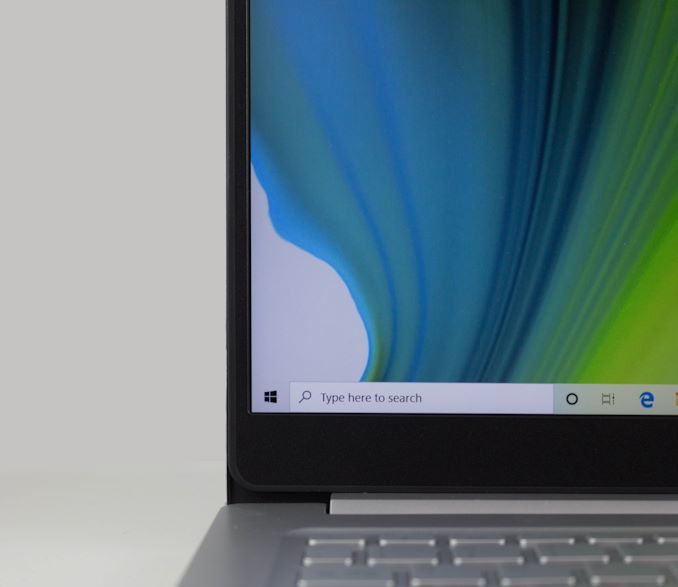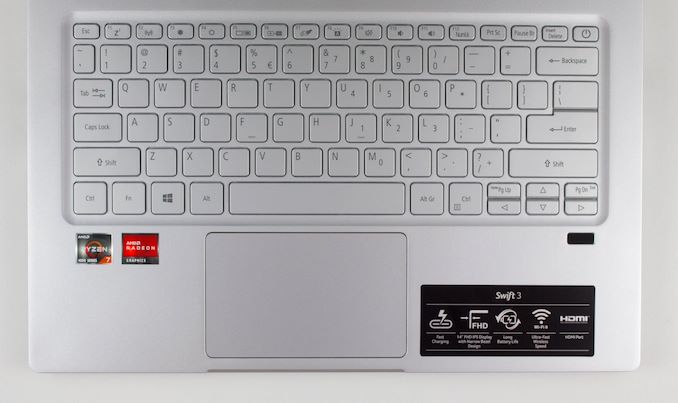The Acer Swift 3 SF314 Notebook Review: Swift Gets Swifter With Ryzen 4000
by Brett Howse & Andrei Frumusanu on May 5, 2020 8:00 AM ESTDesign
Acer’s design ethos for the new Swift 3 would make you think this is a much more expensive device. The 14-inch notebook features an all-aluminum design, offering a much more premium feel than what you’d normally expect on a notebook in this price range. At just 1.2 kg / 2.65 lbs, the 14-inch notebook is extremely portable, and with an 83% screen to body ratio, it is easily as compact as a 13.3-inch notebook from a couple of years ago. Acer’s choice of a 16:9 display does mean that the display has a hefty chin, but is almost certainly a choice that was made to keep the device in-budget.
Despite the thin design and the low price, the aluminum chassis is very stout, with little to no flex no matter how you pick it up. Acer has cut in a slot at the front to make opening the laptop easier, although it will not open with a single finger since the hinge is too stiff to allow this. There is no touch support either, so the hinge stiffness does not need to be quite so tight, but it does make for a solid platform once you open it up.
The keyboard provides a great typing experience. The keys themselves have single-level white backlighting, which works well. The white backlighting on silver keys can cause some contrast issues in bright light, but the effect is not as pronounced as it is on some other devices. Typing offers a surprisingly good keyboard feel, with solid keys that have a solid level of pressure and feedback. Acer has the power button as part of the keyboard, which does make it prone to accidentally turning the device off if you miss the delete key, and moving the power button out of the normal keys would be appreciated, but Acer is far from the only manufacturer to do this, and the laptop resumes instantly so even if it did happen it’s not as big of an issue as it was a few years ago, thanks to the new modern standby options built into Windows and the new CPU.
If there was one area where the notebook showcased it was a lower-cost device, it would be the trackpad. Although it offers the Precision touchpad drivers, the material is not as smooth and responsive as some higher-priced notebooks. This is not so much a knock against the device, but a reality of where it is situated in the market. It does offer the expected multi-touch capabilities you’d expect, it just doesn’t quite offer the level of refinement you’d see in more premium notebooks.
Acer has also included a fingerprint reader, which has great response. It unlocks the device in well under a second even if the display is off. It is a nice to see Windows Hello support despite the lower cost of this device, and the chosen reader seems to work very well. There is no IR camera included, and the built-in webcam is only a 1280x720 unit, so do not expect to be the belle of the Teams meeting, but it gets the job done with a properly located webcam in the top bezel.
Acer offers reasonable I/O as well, with a USB Type-C port on the left, which does support power delivery up to 15 Watts output, and support for charging the device via USB-C as well. There is no Thunderbolt 3, but it does offer DisplayPort output. This is in addition to the included HDMI port, and the laptop also has a USB 3.2 Gen 1 port on the left which supports power-off charging, and a USB 2.0 port on the right, along with a headset jack.
Overall, the Acer Swift 3 is a great design, with a modern feel, and premium materials. The 14-inch notebook is compact, thin, and light, and Acer has done a great job with the look and feel of this device. There are enough ports, and the included USB-C port adds the expanded ability to charge as well as I/O. Looking at this device, you could easily mistake it for a notebook that costs hundreds more.














191 Comments
View All Comments
neblogai - Tuesday, May 5, 2020 - link
If you are interested in such things- check this video about the same laptop: https://youtu.be/awPI4RzKMvY?t=386 (use autotranslate). Basically- he put a thermal pads on the heatpipe so it transfers heat to the aluminum back cover. This allowed higher Cinebench result from cold and also higher and more consistent results in Cinebench loop. Before this modification- two of the 30 CB results were ~10% and 7% lower than others (4:40), while after the modding- all scores were higher, and without drops. Also- with this modification, bottom obviously got warmer, so this is not a solution for everyone.eastcoast_pete - Tuesday, May 5, 2020 - link
Thanks, that is an interesting review and modification. As you stated, the reviewer mentioned (assuming I can trust Google translate of the captioning) that this simple addition of thermal pads reduced the erratic thermal throttling a lot, and how little it would add to the BOM costs. Too bad Acer hasn't taken him up on his suggestion! I would pay an extra $5 for that; it's well worth it.anonomouse - Tuesday, May 5, 2020 - link
Any chance of memory latency and memory bandwidth comparison charts between the machines used in the SPEC2017 page? Would be interesting/useful to see these charts taking into account the performance on memory bound workloads, even if the Ice Lake part is using LPDDR4 and not DDR4 like the other two.wordlv - Tuesday, May 5, 2020 - link
Xps 13 runs @25w. This is known fact!hanselltc - Tuesday, May 5, 2020 - link
What the hell is the laptop doing with its thermal management? The SoC Temp FC5 just doesn't match up with the wattage it is drinking. Is the fan curve bad? Does the chip just flips out when it needs to balance CPU and iGPU powerdraw while it is hovering around the hard throttle temp limit?eastcoast_pete - Tuesday, May 5, 2020 - link
I found that link posted by neblogai a few comments up really informative! Apparently, Acer left a lot of potential, yet straightforward heat dissipation on the table.Hulk - Tuesday, May 5, 2020 - link
AMD is obviously on a roll but looking at these Ice Lake results I'd say Intel ain't dead yet. We have a fight on our hands!watzupken - Wednesday, May 6, 2020 - link
"AMD is obviously on a roll but looking at these Ice Lake results I'd say Intel ain't dead yet. We have a fight on our hands!"Firstly, I don't think it is a good comparison between a top end laptop running the top end Intel Ice Lake chip, and this low end Swift 3, running a mid high end Renoir chip. Top end laptops normally put in more care when it comes to cooling, and I believe this Dell model may be using a dual fan cooling solution despite its small and slim size. The cooling will certainly help improve sustained and burst performance, which in turn affect the benchmark scores. From my experience, Acer Swift 3 typically employs a single fan, single heatpipe cooling solution, which is woefully poor in cooling. If you look at some reviews out there on Ice Lake performance on lower end laptops, you noticed that the sustained clockspeed can go below 2Ghz, which will certainly hurt performance.
Secondly spec wise, the i7 and faster RAMs on the Dell will also give it an edge, against the Ryzen 7 4700U with slower RAM.
In this case, just as the review pointed out in the thermal section, I feel the Ryzen 7 4700U is actually very thermally limited to show its full potential. Hopefully we see other PC makers/ models that will provide better cooling.
Oxford Guy - Thursday, May 7, 2020 - link
Yes, if you limit the AMD chip to 8 watts:"The laptop really struggled with its thermals, dropping the framerate into single digits often. The device attempted to run at around 18 Watts of power draw, slightly over the 15 Watt TDP, but in fact only averaged around 8 Watts during this run."
supdawgwtfd - Tuesday, May 5, 2020 - link
"channels if your router is has the correct capabilities."Wanted! Proof reader/editor.